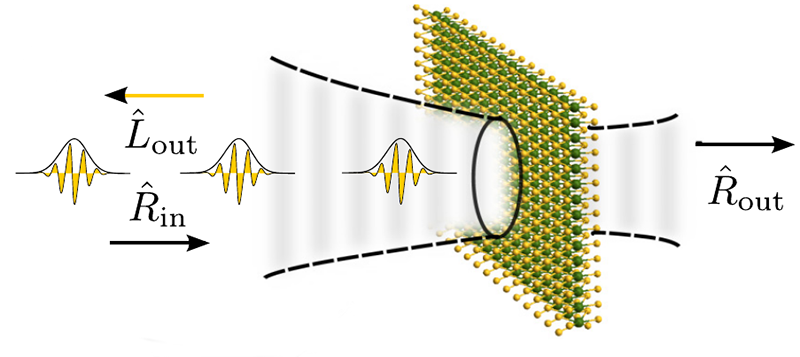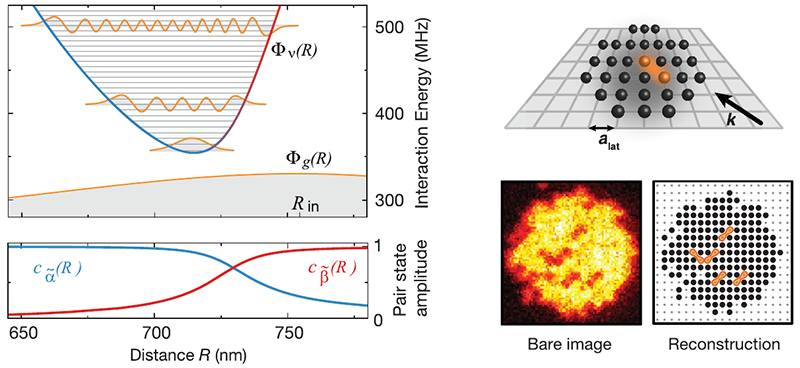Research
A central theme in our research is quantum mechanical correlations that emerge in physical systems with strong interactions. We are particularly interested in their optical response, as it opens the door to new ways of manipulating light, which could be fruitful for quantum information science. We apply and develop both analytical and numerical tools to describe this emergent interplay of light and matter. Rydberg states of atoms and semiconductor excitons provide such interactions as well as an efficient interface to light. Below, you can read about some of the research directions we have recently been investigating.
Nonlinear optics with Rydberg excitons
![]()
Semiconductor excitons are bound states of an electron and a hole that can be excited by visible light. These “artificial atoms” have been known for 70 years. Much more recently, excited states (Rydberg states) of excitons where found, where the electron and hole are separated by up to a micron. We showed here that these Rydberg excitons are very strongly interacting and can even blockade each other. Our group develops analytical and theoretical tools to describe Rydberg excitons, from the few to the many-body limit. Strong signatures of these interactions can be seen in the nonlinear response here (cf. image). We regularly collaborate with a number of experimental colleagues on these topics. Some recent joint work with teams from Dortmund, Durham, and New York.
Going forward, we plan to investigate the quantum mechanical properties of excitons when the they are strongly coupled to a light field and form “polaritons”. This direction is motivated by a recent collaboration with colleagues in St. Andrew’s and Sydney, where we observed and described highly excited Rydberg exciton polaritons for the first time, here.
Collective quantum optics with ordered arrays
 Ordered collections of atoms can react differently to incident light than individual atoms. This collective response becomes pronounced when the atom-atom separation is comparable or smaller than the wavelength of the light. It originates from the finite probability that a photon, after it is scattered by one atom, is reabsorbed by another. Fascinating resulting effects include total reflection by a single two-dimensional array, which has recently been observed. We are interested in finding and using special states that are completely decoupled from light (“dark states”). We have demonstrated a strategy for storage and retrieval of light into such states here. We also develop methods how states of light can be manipulated dynamically. An illustration how this can be realized using Rydberg interactions can be found here and here (with two-dimensional semiconductors, cf. image).
Ordered collections of atoms can react differently to incident light than individual atoms. This collective response becomes pronounced when the atom-atom separation is comparable or smaller than the wavelength of the light. It originates from the finite probability that a photon, after it is scattered by one atom, is reabsorbed by another. Fascinating resulting effects include total reflection by a single two-dimensional array, which has recently been observed. We are interested in finding and using special states that are completely decoupled from light (“dark states”). We have demonstrated a strategy for storage and retrieval of light into such states here. We also develop methods how states of light can be manipulated dynamically. An illustration how this can be realized using Rydberg interactions can be found here and here (with two-dimensional semiconductors, cf. image).
The world's largest di-atomic molecules: Rydberg macrodimers

In conventional molecules, binding appear because electrons from different atoms overlap to form molecular orbitals. Rydberg macrodimers are a curious class of di-atomic molecules held together by induced polarization forces. These are effective over distances as large as a bacteria (750 nm), much longer than the size of each atom. We are interested in the structure and dynamics of such molecules, which present one of the best controlled molecular systems. We have collaborated with experimental colleagues since the first observation of macrodimers in a quantum gas microscope here (cf. image) and the development distance-selective dressing, here. We continue to develop theoretical models for the complex excitation and dynamics of Rydberg macrodimers.